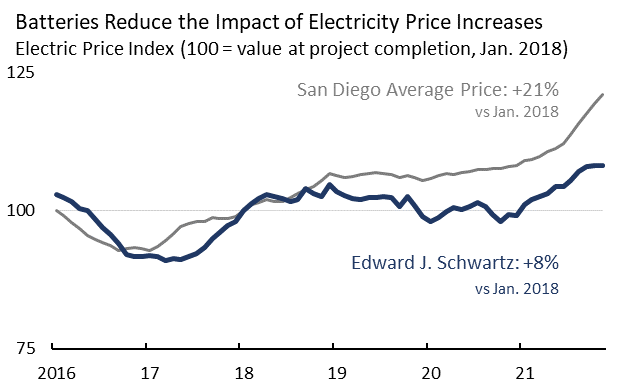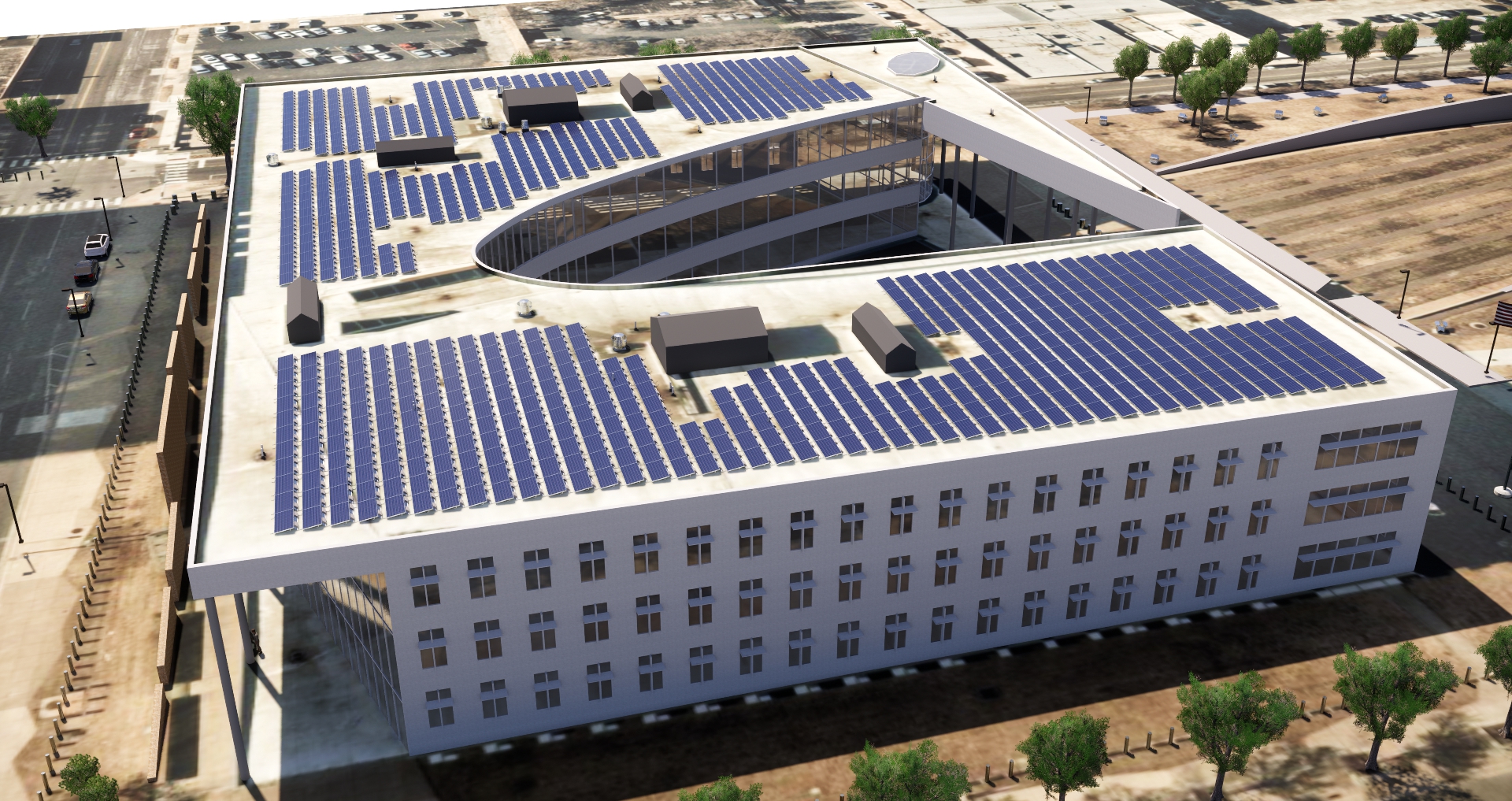
How GSA is using innovative energy storage technologies today to power the government with 100 percent carbon pollution-free electricity by 2030
Post filed in: Climate
Energy storage is a fast-growing resource that helps balance energy supply and demand, save money, facilitate carbon pollution-free energy, and increase resilience. GSA is proud to demonstrate this technology at several of its public buildings today.
Last December, President Biden signed an executive order laying out an ambitious and urgent goal: power the federal government with 100 percent carbon pollution-free electricity by 2030, to lead the U.S. toward a clean energy economy. The good news is that the needed generation, storage, and control technologies to power buildings with 100 percent carbon pollution-free electricity are currently available. The market for these technologies and equipment will continue to grow. The president’s executive order recognizes that, as the largest single consumer of electrical energy in the country, the federal government is uniquely positioned to help drive the market, helping clean energy technology manufacturers achieve economies of scale and innovations that make these technologies even more cost-effective.
The role of energy storage in carbon pollution-free electricity
Energy storage equipment in buildings captures energy when it is inexpensive, available from clean energy sources, or both — then makes it available when needed. Energy storage can provide a range of benefits to the federal government’s property portfolio, and to the grid as a whole — especially when partnered with GSA’s actions to improve efficiency and reduce reliance on fossil fuels. By managing the time and amount of grid energy that must be purchased to power a building, energy storage can include benefits such as:
- Reducing electric charges driven by peak demand charges and variable time of use rates;
- Facilitating participation in local or regional demand response programs, where building owners can be compensated for their energy conservation, due to its value in reducing demand on the electric grid;
- Enabling more usage and savings from on-site energy generation resources, such as solar photovoltaic (PV) panels and wind power;
- Contributing to the continuing stability of the electric grid; and
- Increasing building energy security and resilience by providing back-up power when needed.
As a primary agency that buys electricity and vehicles for the federal government, GSA is working with agency and industry partners to help move toward a sustainable carbon pollution-free energy future. Leveraging the federal government’s buying power will drive development of local clean energy sources while reducing greenhouse gas emissions and supporting well-paying “green collar” jobs across our nation.
Transitioning to100% carbon pollution-free electricity requires the use of energy storage to balance the intermittency of major renewable energy sources - in other words, that the sun isn’t always shining or the wind always blowing. Energy can be stored within buildings, or at off-site utility-scale facilities. Storage acts like a shock absorber that helps cost-effectively match electrical demand with variable clean power generation capacity.
How GSA uses battery storage in its building portfolio today to save money and reduce peak usage
GSA has developed a number of projects validating different approaches to energy storage. GSA’s first battery storage installation has successfully operated since January 2018 at the Edward J. Schwartz Federal Building & U.S. Courthouse in San Diego. This lithium-ion system is capable of several on-grid applications including timing energy use to take advantage of the best rates, reducing usage during peak hours, and automating participation in demand response programs.

Based on its success, additional lithium-ion systems were also included in GSA’s Federal Aggregated Solar Procurement Pilot Projects in San Bruno and Menlo Park in California. These storage systems use optimized control algorithms to minimize costly “demand charges” — utility rates based on a ratepayer’s periods of highest energy use. All three of these installations are in areas where demand-variable electricity rates allow GSA to buy energy when it’s cheaper, saving the taxpayer money. In fact, a recent measurement and verification review showed that the Schwartz building’s battery storage system alone is saving $100,000 in peak demand energy costs each year.
GSA is currently working with energy services companies (ESCOs) and utility partners to install battery storage and battery management solutions that have no upfront cost because they’re financed with the utility cost savings they’ll deliver. GSA worked with an ESCO to deploy large-scale nickel-iron battery energy storage systems in California, at the Glenn Anderson Federal Building in Long Beach and the Ronald Reagan U.S. Courthouse in Santa Ana. These storage solutions were designed to save money. They use a type of battery that can help meet peak electricity demand every business day for 20 years without degradation. These systems pay for themselves when local electricity costs rise — currently during evening hours when solar production decreases. The batteries in Long Beach are currently operational, saving approximately $180,000 per year. When the Reagan Courthouse’s battery storage system in Santa Ana comes online later in 2022, it will save an estimated $300,000 per year.
A dynamic, interactive battery installation coming online at the Oklahoma City Federal Building this spring will use state of the art controls to optimize battery usage and maximize benefits from onsite solar panels. This Oklahoma City installation received a grant from the U.S. Energy Department, with installation done by a utility partner.

Oklahoma City Federal Building
How GSA gives the grid a break with innovative thermal storage systems that heat and cool
Another option is to store energy in a thermal form, as heat or cooling energy, instead of as electrical energy. With proper management, buildings can run cooling systems when energy is more available, and often less expensive — then use the stored thermal energy when needed.
GSA’s John J. Moakley U.S. Courthouse in Boston uses an innovative ice-based thermal storage system that can significantly reduce the electricity needed to cool the building using stored ice during summer days. The sub-basement contains thermal “batteries” that can be frozen when the grid has more capacity, then melted to provide daytime cooling. This helps stabilize the electricity grid, and makes the building more resilient. If there’s a power outage, the emergency generators have capacity to power the thermal pumps and lighting. This allows the Moakley building to operate comfortably running its chillers minimally for one or more summer days — in other words, significantly reducing the use of grid electricity!
At a campus of the Food and Drug Administration (FDA) in White Oak, Maryland, GSA used energy savings performance contract financing to install a two-million gallon chilled water storage system that provides short-term back-up cooling. This equipment provides much-needed resilience for mission-critical lab and vivarium spaces by maintaining thermal conditions during power outages or — during extreme events — by allowing more time to adjust critical research.
The most innovative technology for thermal energy storage is phase-change materials, materials that absorb and release thermal energy based on temperature and which, unlike ice, can be custom-tuned to an optimum freezing point. GSA recently installed this next-generation technology at Seattle’s Federal South campus, where the phase change material is tuned to freeze at 45 degrees F. Recovered heat is used during occupied hours to warm the building, while in the warmer afternoon and evening, the frozen material’s energy is used for spot cooling, using high-efficiency chilled beams. The phase-change material also helps cool computer server rooms during unoccupied hours.
Resources for building managers
Federal building professionals who are adding energy storage to their facilities can consult the new building energy storage module of GSA’s Sustainable Facilities Tool. The content is an extension of the GSA Green Building Advisory Committee’s work on adopting energy storage in federal buildings [PDF - 1 MB].

 U.S. General Services Administration
U.S. General Services Administration
